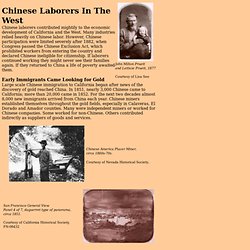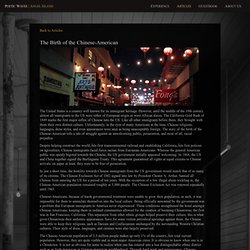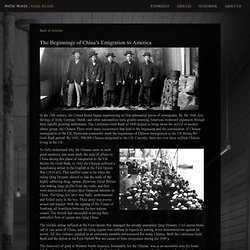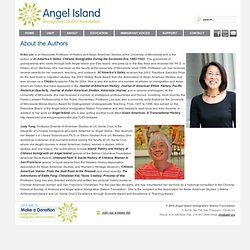

Sequence 5 (Page III): California. California :early history, commercial position, climate, scenery, forests, general resources, irrigation, mining, agriculture, horticulture, olive culture, citrus culture, the sugar beet, raisin growing, transportation, Interactive Map Showing Immigration Data Since 1880 - Interactive Graphic.
Welcome to the Pacific Coast Immigration Museum. Museum of Chinese in America (MOCA) Chinese Immigration. The Chinese in California, 1850-1925 (American Memory, Library of Congress) This collection is no longer updated in American Memory. Please visit the up to date presentation: The Chinese in California, 1850-1925 (external link) Search by Keyword | Browse by Subject | Name | Title | Group | Theme The Chinese in California, 1850-1925 illustrates nineteenth and early twentieth century Chinese immigration to California through about 8,000 images and pages of primary source materials.
Gallery1. Gallery2. Chinese Laborers In The West Chinese laborers contributed mightily to the economic development of California and the West.

Many industries relied heavily on Chinese labor. However, Chinese participation were limited severely after 1882, when Congress passed the Chinese Exclusion Act, which prohibited workers from entering the country and declared Chinese ineligible for citizenship. If laborers continued working they might never see their families again. If they returned to China a life of poverty awaited them. Early Immigrants Came Looking for Gold Large scale Chinese immigration to California began after news of the discovery of gold reached China.
Railroad Construction Employed Thousands In 1863 the Central Pacific began working east from Sacramento, California, on the nation's first transcontinental railroad. Herbal Remedies Made Camp Life Tolerable Since the Chinese did not trust western doctors or western medicine, men like Fong Dun Shung administered to the needs of laborers. 1HOWTHEC_20.jpg (405×281) Angel Island : Poetic Waves, Chinese Immigration History (tour, poems, photos, timeline, history) Angel Island, Chinese-American Immigration History (tour, poems, photos, timeline, history) The United States is a country well known for its immigrant heritage.

Angel Island, Chinese-American Immigration History (tour, poems, photos, timeline, history) In the 19th century, the United States began experiencing its first substantial waves of immigrants.

By the 1840’s, throngs of Irish, German, Dutch, and other nationalities were greatly assisting American westward expansion through their rapidly growing settlements. The California Gold Rush of 1849 helped to bring about the arrival of another ethnic group, the Chinese There were many occurrences that lead to the beginning and the continuation of Chinese immigration to the US. Historians commonly mark the beginnings of Chinese immigration to the US during the Gold Rush period. By 1882, 300,000 Chinese emigrated to the US. Currenly, there are over three million Chinese living in the US. To fully understand why the Chinese came in such great numbers, one must study the state of affairs in China during this phase of emigration to the US.
The terrible defeat suffered at the First Opium War damaged the already unpopular Qing Dynasty. 1. History Lesson 2: History of Immigration From the 1850s to the Present. Please register to download a PDFs of this resource Overview: This lesson continues the history of immigration from 1850 to the present.

Special emphasis is placed on the experience of Chinese immigrants, the "new immigrants" from Southern and Eastern Europe, nativism and restrictive quotas, the 1965 immigration act, and the "new immigrants" from Asia and Latin America in the contemporary era. About the Authors. Erika Lee is an Associate Professor of History and Asian American Studies at the University of Minnesota and is the author of At America's Gates: Chinese Immigration During the Exclusion Era, 1882-1943.

The grandchild of grandparents who came through both Angel Island and Ellis Island, she grew up in the Bay Area and received her Ph.D. in History at UC Berkeley. She has been on the faculty at the University of Minnesota since 1998. Professor Lee has received several awards for her research, teaching, and outreach.
At America's Gates received the 2003 Theodore Saloutos Prize for the best book in migration studies, the 2003 History Book Award from the Association of Asian American Studies, and was chosen as a Choice Academic Title for 2004.